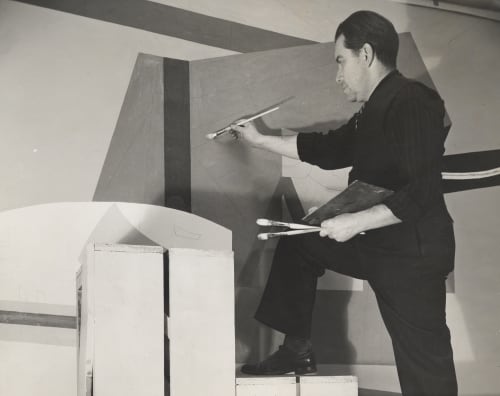Stuart Davis 1892-1964
"Be distinctly American."
- Stuart Davis
Stuart Davis was born in 1892 in Philadelphia, Pennsylvania to a family of artists–– his parents had both received their education and met each other at the Pennsylvania Academy of the Fine Arts. At the time of Davis’s birth, his mother was a practicing sculptor, and his father was the art editor for a Philadelphia publication, the Philadelphia Press. Consequently, Davis grew up in a household that was accepting, even encouraging, of a pathway in the arts, an attitude opposite to the widespread societal opinions on art which viewed it, as a profession, as un-masculine and distinctly European.
Davis’s personal entry into the art world saw him studying under Robert Henri at his eponymous school of art, at which Davis received an unconventional education typical of Henri’s style and genre of painting. Davis, at first, formed part of a ‘second generation’ of Ashcan school painters. In his early ventures into painting, Davis’s art mirrored the urban subject matters and styles of his compatriots in the Ashcan school. Davis was particularly influenced by his good friend John Sloan, whose brushstrokes and figures are reflected in Davis’s early work. And already, in providing illustrations for the magazine ‘Masses,’ Davis proved himself to be a socially conscious man who infused his artwork with his values. However, the trajectory of Davis’s art was changed suddenly and permanently by that famous event which acquainted Americans with the work of European modernists at a scale never seen before, the 1913 Armory Show.
For Davis, the Armory Show was truly pivotal; he cited it in his meticulously kept journals and records as the catalyst for his transformation into the modernist he is remembered as today. Davis stated that the show provided him with “a wealth of new possibilities” and he spent the subsequent decade, a highly formative one full of exploration, delving into the world of modernism and honing his craft. Eventually, Davis would craft a “homegrown, personal brand of American cubism,” though in order to reach a style entirely his own, Davis first cycled through iterations of modernism inspired and influenced by the artists whose work he had seen at the Armory, particularly Matisse, Van Gogh, and Gaugin. Perhaps, Davis’s success in inventing such an original style, bold and adventurous and exciting, can be traced to his status as the “only painter of his generation to penetrate the surface of the style and seek its underlying logic,” as put by Diane Kelder in Stuart Davis: American Painter.
Theory was indeed enmeshed in Davis’s work–– theory as unique and varied as his paintings. Though Davis recognized his work as abstract, he did not see it as simply the abstraction of reality; rather, he saw himself as the creator of a new reality. In the late 20s, Davis also adopted what he called the ‘color-space logic,’ in which he formed his subjects and their relationships in terms of “subtly nuanced” color planes. Such “pictures that tend towards singleness” or are “pared down to eloquent essentials” are often Davis’s strongest, fitting with his meticulous nature (Stuart Davis).
